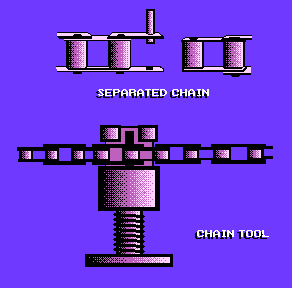"Save Big With Bicycle Discount Coupon Codes"
Bicycle Chain Repair

You can often repair stiff bicycle chain links with oil or careful lateral bending. Severe cases will require replacement of links. Links are replaced in pairs, an inner link and an outer.
One- and three-speed bikes use 1/8-inch wide chain, which use master links. There is one master link per bike chain. These snap on and off easily. There are two types of master links. Two-piece master links are opened by loosening the chain, then gently bending the link toward the outside, so the outer plate of the link is free to be lifted off. Three-piece master links have a clip that slides to one side and then lifts off. When reinstalling three-piece links, install the clip with the open end facing away from the direction of rotation, so that friction between the bike chain and clothing, chainguard, etc, will not accidentally remove it.
Derailleur-equipped bikes have 3/32" bike chains, usually with no master link. All the links are the same. For these chains you need a chain tool, available for under ten dollars at bicycle shops. This tool drives a rivet of any link almost all the way out of the link, making it possible to separate the chain. Never drive the rivet entirely out, since you will not be able to reinstall it. After your chain repair is complete, simply drive the rivet back into position. If stiff, bend the link laterally (carefully) to make it flexible again.
With care, you can use a hammer, nail, and a block of hardwood with a small hole in it, instead of a chain tool to drive a rivet out.
If you are putting a new bicycle chain on a derailleur bike, the correct length is the longest possible while engaged on the smallest rear and smallest front sprockets without sagging.
Never ride a bicycle if you are not sure all the links are in good condition. Chains only break when you are riding really hard, and that's not a good time to lose control of your bike!
It is a wonderful idea to check bikes every week or two for a chain defect. While pedaling slowly and smoothly backward, look at the profile of the links as they pass a fixed point such as around the smallest rear sprocket. If a rivet is not in proper position, it should be fairly easy to see that it differs from its brothers and sisters. Never ride a bike with a defective link.
Some mechanics say bicycle chains should be removed and cleaned periodically in a solvent that is not dangerous. Kerosene is recommended because although it is flammable (be careful), it is not explosive like gasoline. Clean the chain outdoors or in a well-ventilated area. However, some mechanics feel that every time a derailleur chain is removed and reinstalled, it is weakened unless it has a master link.
Oil chains frequently with a small quantity of special chain oil. Chain oil is formulated to lubricate well, but without unduly attracting dust.
Avoid the combination of small sprocket in front and smallest in the back. This causes fast chain and sprocket wear. That's because the smallest front sprocket develops the most power (not speed) and the rear sprocket has the fewest number of teeth to support that power. Instead, switch to a larger front sprocket, and a medium rear one, which will result in almost the same gear ratio. So, even though your bike may have ten, fifteen, or more gear combinations, you don't need and don't want to use all of them.
3 Things You Need To KnowBefore You Buy
![]()
Back - Replacing A Derailleur Cable
Tell a Friend About BikeWebSite
Please feel free to link your web pages to www.bikewebsite.com.
![]()
Copyright © 1991-2014, bikewebsite.com